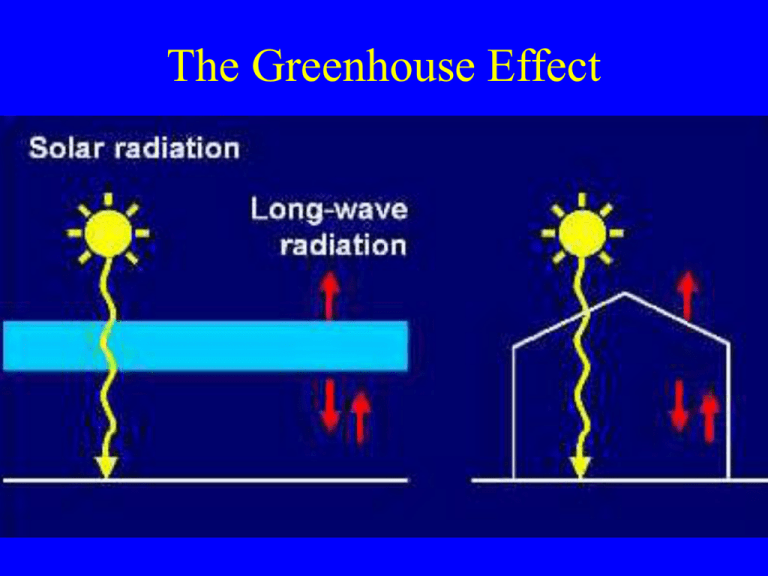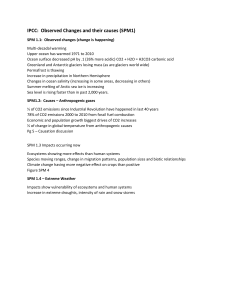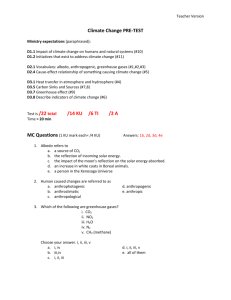The Greenhouse Effect
advertisement

The Greenhouse Effect SPM 3 Concentration of Carbon Dioxide and Methane Have Risen Greatly Since Pre-Industrial Times Carbon dioxide: 33% rise BW 5 The MetOffice. Hadley Center for Climate Prediction and Research. Methane: 100% rise Variations of the Earth’s surface temperature for the past 140 years SPM 1a Variations of the Earth’s surface temperature for the past 1,000 years SPM 1b Certainties • Existence of natural greenhouse effect • Greenhouse gases increasing • Temperature increasing – 1998 the hottest in at least 1000 years. • Sea levels rising – 4 -10” over century Uncertainties • Timing of atmospheric warming, glaciers • The effects of increased cloudiness • Uneven health and ecological impacts • Unanticipated events Effects of global warming People at Risk from a 44 cm sea-level rise by 2080 Assuming 1990s Level of Flood Protection Source: R. Nicholls, Middlesex University in the U.K. Meteorological Office. 1997. Climate Change and Its Impacts: A Global Perspective. Sea-level transgression scenarios for Bangladesh Adapted from Milliman et al. (1989). Forest fires in drying forests Percent of USA with above normal proportion of total annual precipitation from -day extreme events (2” +) BW 7 Karl et al. 1996 Changes in rainfall with doubled CO2 160 140 40°N 40°S Australian land points 120 100 Change in frequency (%) 80 60 40 20 0 –20 0.2-0.4 0.4-0.8 0.8-1.6 1.6-3.2 3.2-6.4 6.4-12.8 12.8-25.6 >25.6 Daily rainfall class (mm day–1) Melting of alpine glaciers Melting of alpine glaciers 1941 and 2004 Melting of ice caps Melting of sea ice, permafrost Other impacts • Tropical diseases, insects move north • Loss of agricultural land • End of ecosystems that cannot shift Future goals? • Reduce CO2 emissions, change economy • World-wide shift to non-fossil energy • Increased energy efficiency CO2 emissions per capita 29 1997 Kyoto Protocol • Cut gases to under 1990 levels by 2012 • China, India exempted for present • Europeans met most goals • U.S. would have to cut energy use 40%; Bush withdrew 2001 Energy growth rates Global, 1990-2100 World OECD US Brazil Japan China India 0.8% 1.1% 1.4% 1.5% 2.7% 3.2% 4.3% 5.5% Conservation • Homes – insulation, less heat, efficient appliances • Vehicles – Drive less, higher mpg • Industry – Less waste, renewable and efficient energy • Land use – More tress (carbon sinks), no sprawl Proposal for 2100 energy use • Renewables (solar, wind, hydro) 50% • Biomass 30% (5x present use) • Nuclear phased out • Fossil fuels 18% (down from 80%) CO2 emissions (1990 -2100) Mtc 7,000 6,000 5,000 4,000 3,000 2,000 1,000 0 1980 2000 2020 2040 Year 2060 2080 2100 2120 Global energy websites World Resources Institute www.wri.org World Energy Council www.worldenergy.org/ World Energy Assessment www.undp.org/seed/eap/activities/wea/ UN Development Program www.undp.org/seed/eap/








